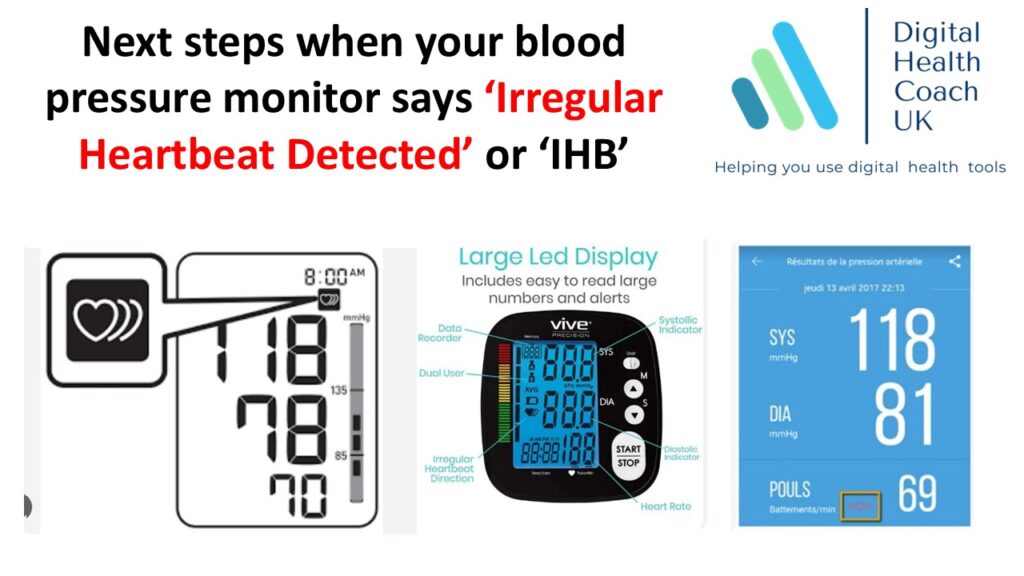
You’ve taken your blood pressure, just as you always do, but this time a small heart symbol flashed up with a message like “irregular heartbeat detected” or “possible AF.”
It’s easy to feel worried — especially if you’ve heard of atrial fibrillation (AF or AFib) but aren’t sure what it means.
The good news is that these alerts don’t mean you’re in immediate danger. They’re simply telling you that your monitor picked up an uneven rhythm in your pulse. It’s a sign to get checked, not a reason to panic.
What is atrial fibrillation (AF or AFib)?
Atrial fibrillation is a type of irregular heartbeat, or arrhythmia. Normally, your heart beats in a steady rhythm: the upper chambers (atria) and lower chambers (ventricles) work together in sequence.
In AF, the atria beat in a chaotic pattern, sending irregular signals to the lower chambers. The result is an uneven pulse, sometimes faster than usual.
It’s common, especially in people over 60 or those with high blood pressure, thyroid problems, or heart disease.
Many people don’t feel any symptoms, while others notice fluttering, tiredness, shortness of breath, or palpitations.
→ NHS: Atrial fibrillation overview
→ Mayo Clinic: Atrial fibrillation (AFib)
How your blood pressure monitor spotted it
When your monitor inflates, it measures tiny pressure changes in your artery with each heartbeat.
If those beats arrive at uneven intervals, the device flags it as an irregular rhythm or possible AF.
Some models, such as the Omron M7 Intelli IT or Microlife BP B3 AFIB, are designed to screen for AF during routine checks.
They can’t diagnose atrial fibrillation — they simply say, “something looks irregular — please have it checked.”
→ British Heart Foundation: How blood pressure monitors can detect an irregular heartbeat
Common causes of irregular readings
Not every irregular pulse means AF. Your monitor might flag an alert if you:
- Move, talk, or laugh during the reading
- Feel anxious or breathe quickly
- Have just exercised or had caffeine
- Place the cuff incorrectly
That’s why it’s important to repeat the measurement calmly before assuming anything serious.
What to do next
- Stay calm and repeat the reading.
Sit quietly for five minutes. Take three readings, one minute apart. If the irregular heartbeat symbol only appears once, it may just be a glitch. - If it appears repeatedly, contact your GP.
Bring your readings (or photos of the display). You can also print your log from the device app. - Your GP will arrange an ECG (electrocardiogram).
This simple test records your heart’s electrical activity and confirms whether it’s really AF.
→ NHS: How an ECG works - If atrial fibrillation is confirmed, treatment is usually straightforward.
You may be prescribed tablets to steady your rhythm or slow your heart rate, and sometimes blood-thinning medication to reduce stroke risk.
→ NHS: Treatments for atrial fibrillation
→ Mayo Clinic: AFib treatment and lifestyle
When to get urgent help
Call NHS 111 or 999 if you feel faint, dizzy, short of breath, or have chest pain or tightness.
Those symptoms don’t automatically mean AF, but they do need checking quickly.
→ NHS 111 online
How to track your readings
Keep a simple log — date, time, blood pressure, pulse, and whether the “irregular” icon appeared.
If you have symptoms such as palpitations, tiredness, or breathlessness, note those too.
Patterns over time help your GP decide whether you need longer-term monitoring such as a 24-hour ECG.
→ BHF: Tests for an irregular heartbeat
Why catching AF early matters
Untreated AF can increase your risk of stroke or heart failure, but when it’s picked up early and treated, that risk drops dramatically.
Your blood pressure monitor has done exactly what it’s meant to do — act as an early-warning system between check-ups.
→ BHF: AF and stroke risk
The takeaway
If your blood pressure monitor says “irregular heartbeat detected” or “possible AFib”:
- Stay calm and repeat the test
- Book a GP appointment if it happens again
- Bring your readings and mention any symptoms
- Seek urgent help only if you feel unwell
You’ve taken an important step in protecting your heart health. Early detection saves lives — and most people with atrial fibrillation live well once treated.
Frequently asked questions
What does “irregular heartbeat detected” on my blood pressure monitor mean?
Should I repeat the reading if I see an irregular heartbeat alert?
Can a home blood pressure monitor diagnose atrial fibrillation (AF)?
When should I seek urgent help?
What will my GP do to check for AF?
If AF is confirmed, what treatments are available?
How accurate are irregular heartbeat alerts on home monitors?
Can a smartwatch help if I get these alerts?
How should I record my readings for the GP?
Does AF increase stroke risk?
Did you mean…?
These are common search phrases and misspellings related to irregular heartbeat alerts on home blood pressure monitors.
| Common misspelling or phrasing | Correct / intended term | Example context |
|---|---|---|
| blood pressure moniter irregular heartbeat | blood pressure monitor irregular heartbeat | Typo “moniter” instead of “monitor” |
| blood preasure monitor irregular | blood pressure monitor irregular heartbeat | Typo “preasure” instead of “pressure” |
| irregular heart beat monitor | irregular heartbeat monitor | Split compound “heart beat” |
| a fib blood pressure machine | atrial fibrillation blood pressure monitor | Spoken or voice-search variant |
| AFIB alert blood pressure | AFib alert blood pressure monitor | Uppercase AFIB; shortened phrase |
| blood pressure machine says irregular | blood pressure monitor irregular heartbeat | Conversational phrasing |
| BP monitor flashing heart symbol | irregular heartbeat icon on BP monitor | Descriptive, often from voice search |
| blood pressure monitor afib symbol | AFib detected on blood pressure monitor | Brand-specific variant |
| blood pressure monitor shows arrhythmia | blood pressure monitor irregular heartbeat / AF | Medical synonym “arrhythmia” |
| blood pressure monitor af reading | blood pressure monitor AF reading | Shorthand “AF” use |
| blood pressure monitor says af | possible AF detected on blood pressure monitor | Minimal phrasing from search logs |
| what does irregular heart mean on bp monitor | what does irregular heartbeat mean on blood pressure monitor | Natural question variant |
| bp monitor heart symbol flashing | blood pressure monitor heart symbol meaning | Icon-based search |
| irregular heart beat on omron | irregular heartbeat on Omron blood pressure monitor | Brand name inclusion |
| microlife AFIB alert | Microlife AFib detection feature | Brand / feature variant |
